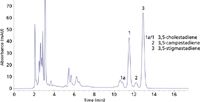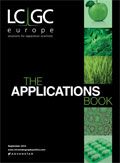Thermal Treatment Analysis — Determination of 3,5-stigmastadienes in Olive Oil Using the Agilent Infinity 1220 LC System with Diode Array Detector
Agilent
3,5-stigmastadienes were analysed in seven olive oil samples using the Agilent 1220 Infinity Mobile LC Solution to differentiate virgin from refined or other thermally-treated olive oil. Because of the robust and rugged 1220 Infinity Mobile LC Solution, it is possible to perform olive oil analysis on-site as a starting point for quality analysis of virgin olive oils.
Introduction
Virgin olive oil can be created only by mild, cold pressing of the olives (Olea europea L.). Thermal or chemical treatment is not allowed in the procedure. There are different analytical methods to differentiate virgin from refined or thermally-treated olive oils. In addition to the determination of stigmastadienes and chlorophyll degradation products, the analysis of the concentration of polymerized triacylglycerides in olive oil is another important factor. The amount of stigmastadienes in commercially refined vegetable oils is dependent on the conditions applied during the refining process. The determination of stigmastadienes in olive oils also detects minor amounts of refined oils in virgin olive oils and is, therefore, an important quality characteristic for virgin olive oils. Because of the ultraviolet (UV) detection of the stigmastadienes analysis method, the 1220 Infinity Mobile LC Solution can be used in a mobile laboratory as a starting point for olive oil quality analysis before further quality analyses are applied in a stationary laboratory.
Experimental Conditions
Column: Agilent LiChrospher C18, 4 × 250 mm, 5 µm (p/n 79925OD-584), Agilent ZORBAX Extend-C18 RRHT, 4.6 × 50 mm 1.8 µm (p/n 727975-902)
Mobile phase: Acetonitrile/methyl tert-butyl ether (70:30)
Flow: 1 mL/min
Stop time: 30 min or 5 min
Injection volume: 10–50 µL, 20 µL
Column temperature: 25 °C
UV: 235 nm/4 nm Ref.: off
Peak width: >0.05 min (1.0 s response time) (5 Hz)
Sample preparation was carried out according to EN ISO 15788-3:2004 (D) using the internal standard method.
Results
In contrast to virgin olive oils, 3,5-stigmastadienes were detected in partly refined olive oil, see Figure 1. To accelerate analysis time, the run was shortened to 5 min using a 50-mm, sub-2 µm column (Agilent ZORBAX Extend-C18 RRHT, 4.6 × 50 mm 1.8 µm), still obtaining good resolution of the analytes in partly refined olive oil.

Figure 1: Detection of 3,5-stigmastadienes in partly refined olive oil.
Conclusion
Seven olive oils were analysed for 3,5-stigmastadiene to determine refining processes or other thermal treatments according to EN ISO 15788-3:2004 (D). As expected, no 3,5-stigmastadienes were detected in any of the tested virgin oils. In contrast, in a sample containing refined and virgin oils, the amount of 3,5-stigmastadienes found was 0.63 mg per kg sample. The analysis time could be shortened to 5 min using a 50-mm, sub2 µm column.
References
(1) Quality Analysis of Virgin Olive Oils — Part 3, Agilent Application Note, Publication Number 5991-1896EN, (2013).
(2) Quality Analysis of Virgin Olive Oils — Part 2, Agilent Application Note, Publication Number 5991-1895EN, (2013).
(3) Dobarganes et al., Pure & Appl. Chem. 71(2), 349–359 (1999).
(4) L. Brühl and H.J. Fiebig, Fat. Sci. Technol. 97(6), 203–208 (1995).
(5) H.J. Fiebig, Fett/Lipid 101, 442–445 (1999).

Agilent Technologies Inc.
5301 Stevens Creek Blvd., Santa Clara, California 95051, USA
Tel: (800) 227 9770

New Study Reviews Chromatography Methods for Flavonoid Analysis
April 21st 2025Flavonoids are widely used metabolites that carry out various functions in different industries, such as food and cosmetics. Detecting, separating, and quantifying them in fruit species can be a complicated process.
Analytical Challenges in Measuring Migration from Food Contact Materials
November 2nd 2015Food contact materials contain low molecular weight additives and processing aids which can migrate into foods leading to trace levels of contamination. Food safety is ensured through regulations, comprising compositional controls and migration limits, which present a significant analytical challenge to the food industry to ensure compliance and demonstrate due diligence. Of the various analytical approaches, LC-MS/MS has proved to be an essential tool in monitoring migration of target compounds into foods, and more sophisticated approaches such as LC-high resolution MS (Orbitrap) are being increasingly used for untargeted analysis to monitor non-intentionally added substances. This podcast will provide an overview to this area, illustrated with various applications showing current approaches being employed.

.png&w=3840&q=75)

.png&w=3840&q=75)



.png&w=3840&q=75)



.png&w=3840&q=75)















